by atmara | May 8, 2017 | Art, Mandala History, Mandala Monday, Mandalas, Meditation, yoga
The Mandala – Origin and use
The way in which Mandalas are made is already ancient. In the prehistory, the first simple representations were made, which can be compared with the mandala. These include, for example, rock drawings, which according to estimates by archaeologists could be 25,000 to 30,000 years old. These represented circles with a center, which are interpreted by the scientists as sun cycles.
Also in the Celts culture, the Indians, the Aborigines Australia and the South-American Inkas round sample forms with a center were found. In the emergence of different cultures and religions in Asia, the representations of the mandalas were artistically refined and provided with a great variety of colors. The impressive cult designs were filled with religious content and used in various religious rites in the East Asian countries and in India.
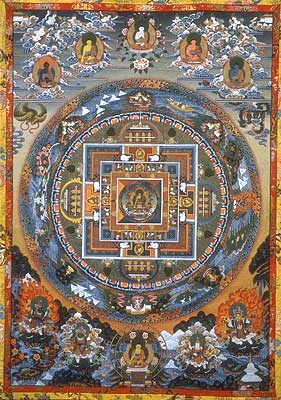
Tibetan Mandala
The versatile use of mandalas
For religions such as Buddhism and Hinduism, which are oriented towards the production of inner and outer harmony as the basis of knowledge and salvation, the mandalas became important objects for meditation. The forms are also found in Christian sacred temples. Medieval church windows and church paintings are often provided with similar representations.
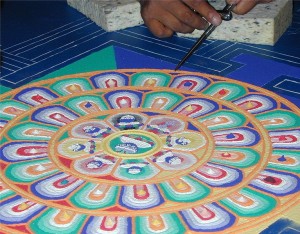
Tibetan monks making a temporary “Sand-Mandala”
in the City-Hall of Kitzbuehel in Austria.
Symbolic representations as a triangle with rays, the Holy Spirit as an illuminated circle, and similar symbols also use the representation principles of the mandala. The centered images greatly enhance the concentration in a meditation.
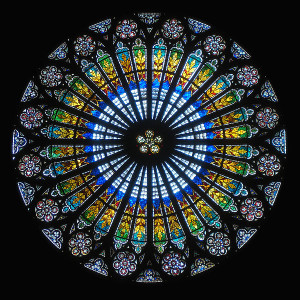
Interior of the rose at Strasbourg Cathedral.
Mandalas in Psychology?
C. G. Jung, a famous psychologist, used the principle of mandalas for examinations and treatments. He noted that a mandala can show the sense of purpose and direction. The Mandalas could convey a sense of structure, security, hope and wholeness in an intense concentration on the picture. In patients, he even found that in certain situations they spontaneously painted mandala forms when asked to paint without prescriptions.
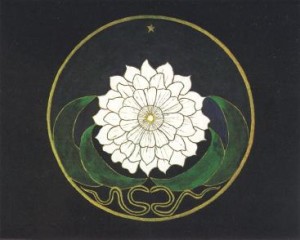
Mandala made by a Jung’s unknown patient before 1929
To date, there are numerous psychologists who use the mandala in their practice. This is based on the realization that the symbolism of a mandala always directly addresses the subconscious. The importance of mandalas, especially the circular shapes and shapes of squares, as an important element in meditation. In deepening into the pictorial representation, in which everything leads to the center, it is particularly well to sink into deep meditation. Especially in Tibet and India, the Mandalas served as meditation symbols and ritual actions.
Mandalas as a help in meditating
In practice, people can use different mandalas in meditation. Regardless of the complicated magical and ritual meanings that the individual mandalas have in different directions of Buddhism and Hinduism, their form is an excellent support. It is helpful to deal with the most important forms and colors at least.
This can accompany the attainment of a deep meditative state of content and lead to the desired emotions. As already mentioned in connection with mandalas in psychology, the subconscious is particularly addressed by each mandala. The view of the mandala, the deepening of its forms and colors, ensures a better concentration. Especially, the view should be directed towards the center.
Nothing around the mandala should distract from meditation. Depending on the condition of the person concerned in the meditation, the mandala can help to feel more peace, harmony, and serenity or to gain new strength, and to release one’s energies for vitality and creativity. However, a mandala never has a detachment from the person. It is always only a means, an important help with intensive meditation and the sinking into one’s own, deeper ego. The actual meditation, the concentration necessary for it always must the man himself. This can not be replaced by the effect of a mandala.
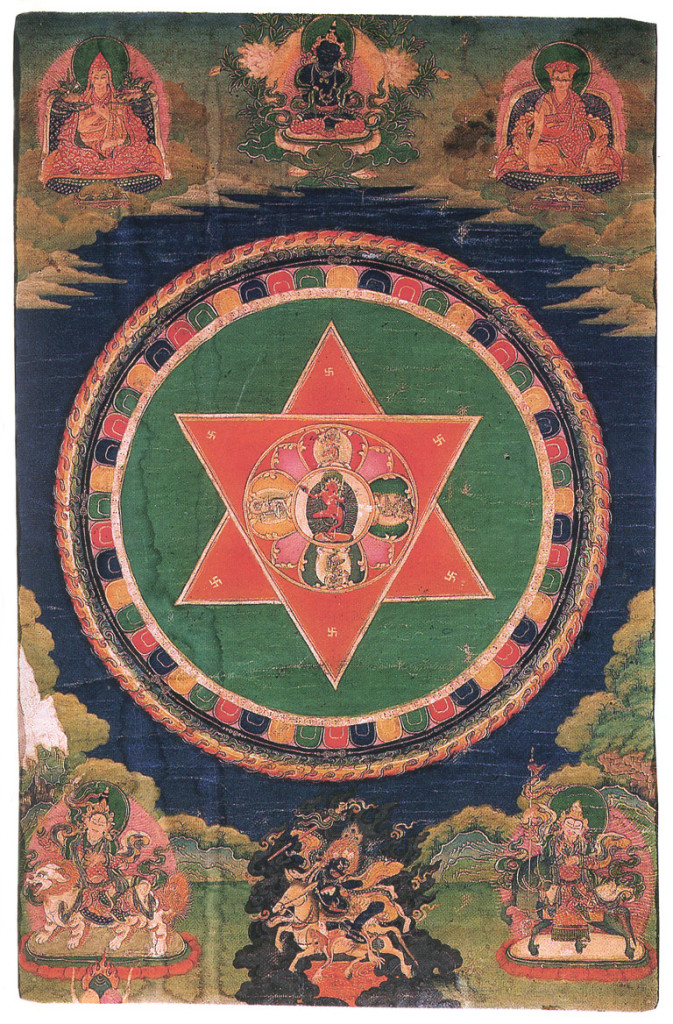 Vajravarahi Mandala
Vajravarahi Mandala
Mandalas, especially in Hinduism and Buddhism, have a ritual meaning as an element of meditation. However, the application goes far beyond the actual roots, so that the psychology and the meditation of the geometric mandala forms positively serve itself. And no, Mandalas do not have to be round. Most of them are actually.
For other offerings of The Yoga Mandala see:
Mandala Beach Blankets
Mandala Tapestry
The Yoga Mandala
——————————————————————————————————–
I look forward to your thoughts and comments!
Like this:
Like Loading...
by atmara | Dec 9, 2013 | Art, Mandala Monday, Mandalas, Music
As a lover of Early Music, I have been familiar with Hildegard of Bingen’s chants for many years, but I had no idea she (or anyone else in the western world) created mandalas in the Middle Ages. Not being a historian of art I assumed the form came from the east (Tibet, India) and was delighted to see this article about Monastic Mandalas. I’m also delighted that Lillain Sizemore was gracious enough to allow me to reprint her blog post here. Thank you Lillian, for allowing me to share this with my readers.
—————————————————————————————————————————
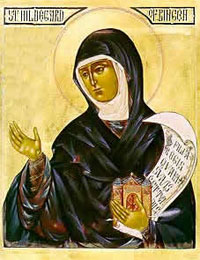
As a child, I often saw or felt ‘entities’ from other worlds. Many children report supersensory experiences and one such child was Hildegard von Bingen.
Hildegard of Bingen, (1098-1179) was born a tenth child to a German noble family. She was an influential and spiritual woman whose fierce devotion paved the way for future generations of women to succeed in fields from theology, to medicine, to music and art. At a very early age she claimed to experience supernatural visions of a powerful, transformative light, but she hid her prophetic abilities until much later in life. She was admitted into a convent at the age of eight, and was prepared for a life of hermetic devotion and meditation.
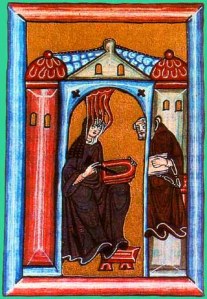
Although Hildegard was not formally educated, her desire to record her visions and messages into book form was undeterred. She relied on secretaries to help transcribe her ideas onto paper and was a prolific writer on topics of philosophy, herbal medicine, the natural world, and a noted composer of hauntingly beautiful chants.
Hildegard became a well-regarded authority and the Mother Superior of her convent. Around 1135, at age 42, she undertook a series of visionary symbolic paintings in unmistakable mandala-forms. While she did not make the illustrations herself, it is thought that she oversaw their production. These cosmic memories occur in myth and archtypes we readily recognize. The pictures were thought to be as strong or stronger than the words themselves. There is a gesltalt immediacy, what Hindu’s refer to as darshan, meaning the simultaneous act of seeing and being seen by a deity.

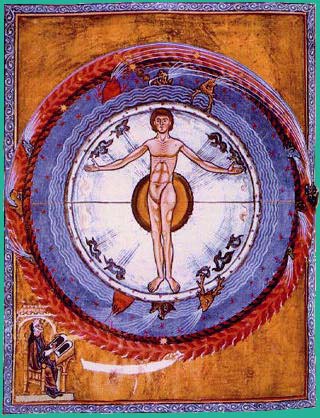
Universal Man. Manuscript illumination from
Liber divinorum operum or De operatione dei
(Book of Divine Works) by Hildegard of Bingen,
1163–74. Biblioteca Statale, Lucca

She created a drawing, or illumination, in her manuscript Scivias (Know the Ways), circa 1140–50, of her defining vision, in which the great span of the universe revealed itself to her in a trance as “round and shadowy…pointed at the top, like an egg…its outermost layer of a bright fire.”
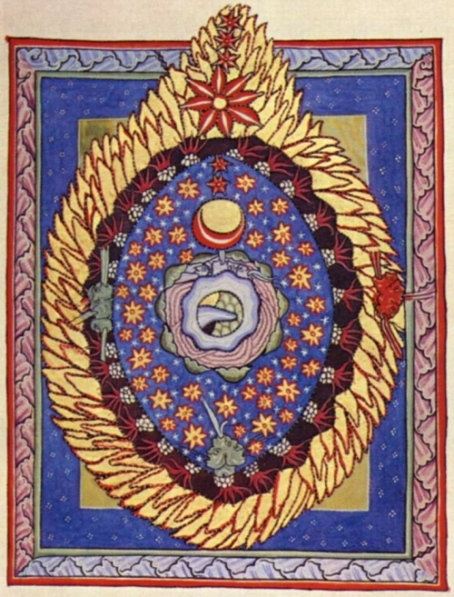
Das Weltall. Manuscript illumination from Scivias
(Know the Ways) by Hildegard of Bingen (Disibodenberg: 1151)

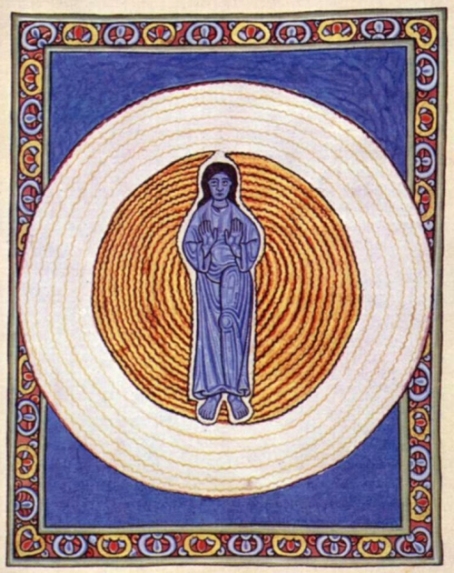
Die wahre Dreiheit in der wahren Einheit.
Manuscript illumination from Scivias (Know the Ways)
by Hildegard of Bingen (Disibodenberg: 1151)

Hildegard’s visions led her to channel cosmic laws into illuminations and illustrate invisible concepts such as ethers, air, and wind. She assigns meaning to these elements to represent such virtues as atonement, righteousness, and moderation.

Cultivating the Cosmic Tree

Central to her mandala paintings is the understanding of a ‘cosmic equilibrium’ and a reverence for all life. In her use of ‘quartering of the circle’ we recognize the four elements (fire, air, water and earth), an archetypal depiction also used by Native American sand painters for the four sacred directions. Her concept of Viriditas, the Greening, was a precursor to our ecology movement. She described this power as the agent of the God, a divine vitality, that was the animating life-force within all creation. This ‘Greenness’ was the very expression of Divine Power on Earth.
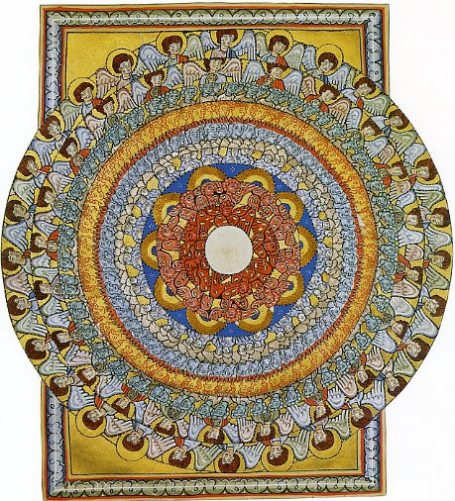
All Beings Celebrate Creation

As Stephanie Roth explains in her article The Cosmic Visions of Hildegard of Bingen:
Since this extraordinary phenomenon called life could only be created by God,
Hildegard believed, all that lives equally carried his Divine energy,
or ‘viritas’ [sic]. In her own words:
Oh fire of the Holy Spirit,
life of the life of every creature,
holy are you in giving life to forms…
Oh boldest path,
penetrating into all places,
in the heights, on earth,
and in every abyss,
you bring and bind all together
From you clouds flow, air flies,
Rocks have their humours,
Rivers spring forth from the waters
And earth wears her green vigour
O ignis Spiritus Paracliti
This is the foundation upon which all her texts rest, whether songs, visions or natural observations.
In a time when women were not allowed self-expression, Hildegard used art for very specific communicative purposes.Though she did not use traditional reasoning to arrive at her realizations, she presents us with subjective experience of the heart, through art, poetry, and music. Her work allows us to interpret and mold the ideas to our own personal experience and situation. This is not unlike the direct experience one can have with the illuminations in the recently published tome of C. G. Jung, the Red Book: Liber Novus.
There is a wealth of academic research available, and a growing curiosity and acceptance of her works. Perhaps now is the time for Hildegard’s fifteen minutes of fame? Just released, is a gorgeous, new German-language film “Vision” by Margarethe von Trotta.
Article © Lillian Sizemore, http://www.sfmosaic.wordpress.com
Bio:
Lillian Sizemore is a professional artist, educator, and independent scholar. She creates mandalas and observes pattern and geometry to connect to a deeper vibration of harmony and universal wholeness. Her mosaic work is featured in Mosaic Techniques and Traditions and Mosaic Art and Style. Lillian has traveled widely, documenting mosaic sites around the world. She authored A Guide to Mosaic Sites: San Francisco (http://www.sfmosaic.com/guidebook/index.php), a walker’s guide to publicly accessible mosaic sites, as well as many articles and book reviews. She is an invited artist-lecturer at the Getty Vila and on the faculty at the Institute of Mosaic Art.
http://www.sfmosaic.wordpress.com
http://www.sfmosaic.com
http://twitter.com/Musiva
———————————————————————————————————
I look forward to your thoughts and comments!
Be sure to Subscribe to this blog either by RSS or Email via the forms on the top right column of the page.
Like this:
Like Loading...
by atmara | Dec 26, 2011 | Art, Healing, Mandala Monday, Mandalas, Peace

The circle is a universal symbol. It appears everywhere in nature that we chose to look: sun, moon, rings on a tree trunk, in a bird’s nest or a lotus flower. It can be found in the iris of the eye or in the cells of the body. These are portals to the greater world, the unseen the Divine. Mandalas are a part of many spiritual traditions around the world. A major part of most eastern religious traditions, mandalas take the viewer into the mysteries of the mind in a wordless meditation. Usually in Buddhist traditions, the circle is enclosed with a deity at each corner, by absorbing the Deities into the unconscious mind, the viewer can shift their focus from the distractions of the outside world into self awareness, love and healing. C.G. Jung the famous Swiss Psychologist instituted the use of mandala in Western Europe as tools for integrating the psyche and accessing the unconscious. He believed that by putting personal symbols in the circle, the mandala itself had healing properties. In Native American tradition, sand mandala is used for healing and teaching about life and community.
In the realm of healing and holistic medicine, mandalas are powerful forms of transformation and integration. They can express anger, pain, grief, and sorrow all within the safe and sacred experience. Mandalas can show us where we have been and where we are going. The process of creating is transformative in itself. The process of viewing can take us deeper into ourselves, creating profound changes. According to David Fontana, PhD. Author of Learn to Meditation. “Their images speak directly to the unconscious, producing and experience of profound harmony and a mystical sense of oneness with the spiritual forces that they represent.” In recent years, Mandalas have been used to enhance Western medical practices. Linda Cornell, PhD., has been using this work to help people in physical crisis create symbolic healing. She used this in combination with traditional medicine when dealing with her own cancer.”Combining these methods proved quite successful. I felt happy that I had taken sensible responsibility for my part in the cure while working in tandem with established medicine.” A number of years ago I participated in one of her workshops, I was personally amazed and in awe at the healing that came through. One of my favorite exercises tapped into our own ability to heal, to be conduits of Divine Light.This exercise is adapted from her book, Mandala Luminous Symbols for Healing. Draw an 18 inch circle on black paper with a white pencil. Within the center draw a smaller circle. Next use a white pencil to trace the outline of your hands and arms inside the larger circle. Leave the center circle blank. Draw very lightly. Have your hands overlap or touch in some way. Now close your eyes. Feet flat on the floor, hands in your lap. Slowly take three deep breaths. With each inhalation bring in peace, joy and love. With each exhalation, release tension, stress and worry. Keeping your heart and mind open, imagine bringing a golden light down through the top of your head, the Divine Life Force through your head, neck and shoulders, arms, into your hands and fingers. Concentrate on this beautiful divine light moving through your body, your lungs, your heart, your other organs. Feel the warmth and healing light moving into your pelvis, down your legs and into your feet and toes. Continue directing this love energy into all the cells of your body. Know that you have the ability to radiate health and happiness, love and peace at any moment into the essence of who you are. Imagine the Divine Light coming through your hands and fingers as vibrant good health. When you feel or have an image of vibrant good health open your eyes.Take your white pencil and draw the vibrant good health image in the center circle. Then draw the Divine Light coming from your fingers. When you have finished your drawing, step back from it. Spend a few minutes just looking, contemplating the possibility that the answers are always within you. There is a life force within each of us that can be accessed and used to transform our lives. Remember you have the ability to heal yourself. The final part of this exercise is to write an affirmation affirming your good health. I am healthy, whole and complete. I listen with love to my body. The answers are within me.
About Author : Rae Luskin, a Chicago artist, teacher, activist and the author of ART FROM MY HEART, is a leader in using creative expression to foster self-worth, resilience, healing and social change. For more information, visit our site : www.raeluskin.net
——————————————————————————————————-
I look forward to your thoughts and comments! Be sure to Subscribe to this blog either by RSS or Email via the forms on the top right column of the page.
Like this:
Like Loading...




 Vajravarahi Mandala
Vajravarahi Mandala







